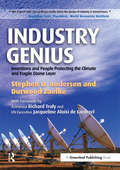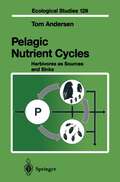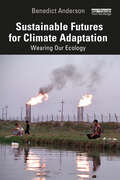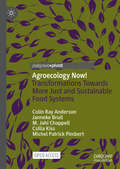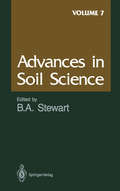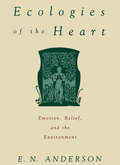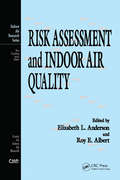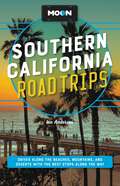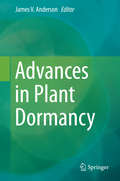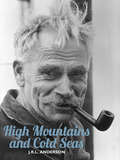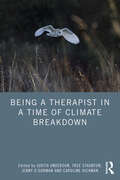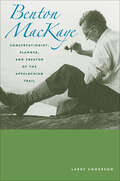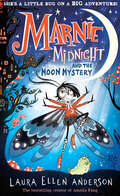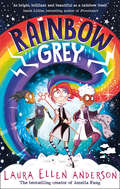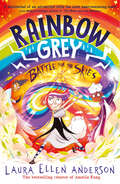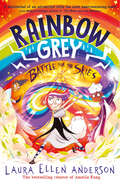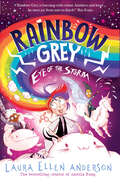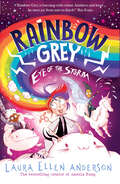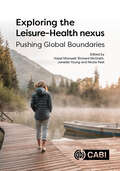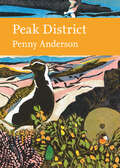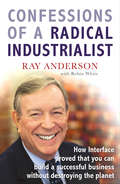- Table View
- List View
Industry Genius: Inventions and People Protecting the Climate and Fragile Ozone Layer
by Stephen Andersen Durwood ZaelkeThis book presents the inventive genius behind technological breakthroughs by ten global companies including Alcoa, DaimlerChrysler, Honda, ST Micro and Visteon. Readers will gain understanding and insight into how cutting-edge technology is helping protect the climate and/or the ozone layer, while contributing to the company's bottom line. Each chapter chronicles the challenge and triumph of invention, introduces the engineers and executives who overcome conventional wisdom, and demonstrates the contribution these companies are making to environmental protection. In full colour and crammed with graphics to illustrate the creative process of technological breakthroughs, the book is accessible and informative. The genius of these ten companies will inspire the engineer, the policy-maker, the student, the environmentalist, the CEO and the investor alike.
Pelagic Nutrient Cycles: Herbivores as Sources and Sinks (Ecological Studies #129)
by Tom AndersenAn analysis of the interactions between pelagic food web processes and element cycling in lakes. While some findings are examined in terms of classical concepts from the ecological theory of predator-prey systems, special emphasis is placed on exploring how stoichiometric relationships between primary producers and herbivores influence the stability and persistence of planktonic food webs. The author develops simple dynamic models of the cycling of mineral nutrients through plankton algae and grazers, and then goes on to explore them both analytically and numerically. The results thus obtained are of great interest to both theoretical and experimental ecologists. Moreover, the models themselves are of immense practical use in the area of lake management.
Sustainable Futures for Climate Adaptation: Wearing Our Ecology
by Benedict AndersonConsidering sustainability as a flawed and restrictive term in practice, Sustainable Futures for Climate Adaptation argues that we must radically adapt humanity and reform society, cities, buildings, and our approach to migration in order to coexist in harmony with our natural environments. The book conceives an Earth–human coexistence where the world’s regions are shared globally between all people, in contrast to a reality where we have lost touch with the natural world. It is this decoupling of humanity and nature that has brought us to the brink of climate disaster. In response, Benedict Anderson explores the concept of ‘wearing our ecology’, where human mobility is synchronized with the environment, merging people with landscapes, topographies, and geographies. Anderson argues that we need to create new migration routes for people moving between the Global South and North and establish flexible and adaptive living environments. Only by rethinking separations between urban and rural, resource extraction and consumption, racial prejudice and accessibility are we able to forge a closer partnership with nature to adapt to climate change and mitigate the worst of its effects. Touching on themes of adaptive urban design, racial and gender segregation and inequality, and climate apocalypticism, this book will be valuable reading for researchers, scholars, and upper-level students in the fields of urban studies, migration studies, human geography, ecology, politics, and design.
Sustainable Futures for Climate Adaptation: Wearing Our Ecology
by Benedict AndersonConsidering sustainability as a flawed and restrictive term in practice, Sustainable Futures for Climate Adaptation argues that we must radically adapt humanity and reform society, cities, buildings, and our approach to migration in order to coexist in harmony with our natural environments. The book conceives an Earth–human coexistence where the world’s regions are shared globally between all people, in contrast to a reality where we have lost touch with the natural world. It is this decoupling of humanity and nature that has brought us to the brink of climate disaster. In response, Benedict Anderson explores the concept of ‘wearing our ecology’, where human mobility is synchronized with the environment, merging people with landscapes, topographies, and geographies. Anderson argues that we need to create new migration routes for people moving between the Global South and North and establish flexible and adaptive living environments. Only by rethinking separations between urban and rural, resource extraction and consumption, racial prejudice and accessibility are we able to forge a closer partnership with nature to adapt to climate change and mitigate the worst of its effects. Touching on themes of adaptive urban design, racial and gender segregation and inequality, and climate apocalypticism, this book will be valuable reading for researchers, scholars, and upper-level students in the fields of urban studies, migration studies, human geography, ecology, politics, and design.
Agroecology Now!: Transformations Towards More Just and Sustainable Food Systems
by Colin Ray Anderson Janneke Bruil M. Jahi Chappell Csilla Kiss Michel Patrick PimbertThis open access book develops a framework for advancing agroecology transformations focusing on power, politics and governance. It explores the potential of agroecology as a sustainable and socially just alternative to today’s dominant food regime. Agroecology is an ecological approach to farming that addresses climate change and biodiversity loss while contributing to the Sustainable Development Goals. Agroecology transformations represent a challenge to the power of corporations in controlling food system and a rejection of the industrial food systems that are at the root of many social and ecological ills. In this book the authors analyse the conditions that enable and disable agroecology’s potential and present six ‘domains of transformation’ where it comes into conflict with the dominant food system. They argue that food sovereignty, community-self organization and a shift to bottom-up governance are critical for the transformation to a socially just and ecologically viable food system. This book will be a valuable resource to researchers, students, policy makers and professionals across multidisciplinary areas including in the fields of food politics, international development, sustainability and resilience.
Advances in Soil Science (Advances in Soil Science #7)
by D. W. Anderson E. Bresler W. W. Frye L. Metzger M. S. Smith J. J. Varco J. Venkateswarlu B. YaronThe world population in 1950 was 2. 5 billion and is more than 5 billion today. The agriculture community, however, has responded remarkably well to meeting the increased need for food and fiber. While the population growth during this period averaged almost 2% annually, the production of grain increased at an even faster rate. From 1950 to 1973, grain production increased 3. 1% annually, but slowed to about 2% from 1973 to 1984. There fore, as a whole, the world has more grain per capita available today than ever before. Several countries that were food importers just a few years ago are food exporters today. The world carry-over stocks today are the highest in years. While the major concern just a few years ago was whether the world could produce adequate food, the problem for many countries today is how to export their surpluses. Although the world as a whole has surplus food supplies, there are millions of people without adequate food to exist, and there are additional millions who have a bare subsistence diet at best. The average daily calorie supply for the developed countries is more than 3,300 per person, while the average for the developing countries is only about 2,200. The major global food produc tion problems have shifted from Asia to Africa, where malnutrition, poverty, and starvation are attracting world attention.
Ecologies Of The Heart: Emotion, Belief, And The Environment
by E. N. AndersonThere is much we can learn about conservation from native peoples, says Gene Anderson. While the advanced nations of the West have failed to control overfishing, deforestation, soil erosion, pollution, and a host of other environmental problems, many traditional peoples manage their natural resources quite successfully. And if some traditional peoples mismanage the environment--the irrational value some place on rhino horn, for instance, has left this species endangered--the fact remains that most have found ways to introduce sound ecological management into their daily lives. Why have they succeeded while we have failed? In Ecologies of the Heart , Gene Anderson reveals how religion and other folk beliefs help pre-industrial peoples control and protect their resources. Equally important, he offers much insight into why our own environmental policies have failed and what we can do to better manage our resources. A cultural ecologist, Gene Anderson has spent his life exploring the ways in which different groups of people manage the environment, and he has lived for years in fishing communities in Hong Kong, Malaysia, Singapore, Tahiti, and British Columbia--as well as in a Mayan farmtown in south Mexico--where he has studied fisheries, farming, and forest management. He has concluded that all traditional societies that have managed resources well over time have done so in part through religion--by the use of emotionally powerful cultural symbols that reinforce particular resource management strategies. Moreover, he argues that these religious beliefs, while seeming unscientific, if not irrational, at first glance, are actually based on long observation of nature. To illustrate this insight, he includes many fascinating portraits of native life. He offers, for instance, an intriguing discussion of the Chinese belief system known as Feng-Shui (wind and water) and tells of meeting villagers in remote areas of Hong Kong's New Territories who assert that dragons live in the mountains, and that to disturb them by cutting too sharply into the rock surface would cause floods and landslides (which in fact it does). He describes the Tlingit Indians of the Pacific Northwest, who, before they strip bark from the great cedar trees, make elaborate apologies to spirits they believe live inside the trees, assuring the spirits that they take only what is necessary. And we read of the Maya of southern Mexico, who speak of the lords of the Forest and the Animals, who punish those who take more from the land or the rivers than they need. These beliefs work in part because they are based on long observation of nature, but also, and equally important, because they are incorporated into a larger cosmology, so that people have a strong emotional investment in them. And conversely, Anderson argues that our environmental programs often fail because we have not found a way to engage our emotions in conservation practices. Folk beliefs are often dismissed as irrational superstitions. Yet as Anderson shows, these beliefs do more to protect the environment than modern science does in the West. Full of insights, Ecologies of the Heart mixes anthropology with ecology and psychology, traditional myth and folklore with informed discussions of conservation efforts in industrial society, to reveal a strikingly new approach to our current environmental crises.
Ecologies of the Heart: Emotion, Belief, and the Environment
by E. N. AndersonThere is much we can learn about conservation from native peoples, says Gene Anderson. While the advanced nations of the West have failed to control overfishing, deforestation, soil erosion, pollution, and a host of other environmental problems, many traditional peoples manage their natural resources quite successfully. And if some traditional peoples mismanage the environment--the irrational value some place on rhino horn, for instance, has left this species endangered--the fact remains that most have found ways to introduce sound ecological management into their daily lives. Why have they succeeded while we have failed? In Ecologies of the Heart, Gene Anderson reveals how religion and other folk beliefs help pre-industrial peoples control and protect their resources. Equally important, he offers much insight into why our own environmental policies have failed and what we can do to better manage our resources. A cultural ecologist, Gene Anderson has spent his life exploring the ways in which different groups of people manage the environment, and he has lived for years in fishing communities in Hong Kong, Malaysia, Singapore, Tahiti, and British Columbia--as well as in a Mayan farmtown in south Mexico--where he has studied fisheries, farming, and forest management. He has concluded that all traditional societies that have managed resources well over time have done so in part through religion--by the use of emotionally powerful cultural symbols that reinforce particular resource management strategies. Moreover, he argues that these religious beliefs, while seeming unscientific, if not irrational, at first glance, are actually based on long observation of nature. To illustrate this insight, he includes many fascinating portraits of native life. He offers, for instance, an intriguing discussion of the Chinese belief system known as Feng-Shui (wind and water) and tells of meeting villagers in remote areas of Hong Kong's New Territories who assert that dragons live in the mountains, and that to disturb them by cutting too sharply into the rock surface would cause floods and landslides (which in fact it does). He describes the Tlingit Indians of the Pacific Northwest, who, before they strip bark from the great cedar trees, make elaborate apologies to spirits they believe live inside the trees, assuring the spirits that they take only what is necessary. And we read of the Maya of southern Mexico, who speak of the lords of the Forest and the Animals, who punish those who take more from the land or the rivers than they need. These beliefs work in part because they are based on long observation of nature, but also, and equally important, because they are incorporated into a larger cosmology, so that people have a strong emotional investment in them. And conversely, Anderson argues that our environmental programs often fail because we have not found a way to engage our emotions in conservation practices. Folk beliefs are often dismissed as irrational superstitions. Yet as Anderson shows, these beliefs do more to protect the environment than modern science does in the West. Full of insights, Ecologies of the Heart mixes anthropology with ecology and psychology, traditional myth and folklore with informed discussions of conservation efforts in industrial society, to reveal a strikingly new approach to our current environmental crises.
Risk Assessment and Indoor Air Quality (Indoor Air Research)
by Elizabeth L. AndersonWith the recent tightening of air quality standards as mandated by the U.S. EPA, has come great pressure on regulatory bodies at all levels of government, along with the industries and groups affected by these standards, to better assess the hazards and risks that result from air pollutants. Risk Assessment and Indoor Air Quality carefully ties tog
Risk Assessment and Indoor Air Quality (Indoor Air Research)
by Elizabeth L. AndersonWith the recent tightening of air quality standards as mandated by the U.S. EPA, has come great pressure on regulatory bodies at all levels of government, along with the industries and groups affected by these standards, to better assess the hazards and risks that result from air pollutants. Risk Assessment and Indoor Air Quality carefully ties tog
Moon Southern California Road Trips: Drives along the Beaches, Mountains, and Deserts with the Best Stops along the Way (Travel Guide)
by Ian AndersonHit the beach, hike hidden trails, or soak up some desert sun: the outdoor adventures are endless with Moon Southern California Road Trips.Pick Your Road Trip: Find flexible getaways throughout SoCal like three-day routes up the coast, through Death Valley, Ojai, and more, or combine them for an epic two-week driving tour Eat, Sleep, Stop and Explore: With lists of the best beaches, hikes, wineries, and more, you can tour backlots in Los Angeles, feel like a kid again at Disneyland, and feast on tacos and craft beer in San Diego. Climb Joshua Tree's rock formations to stunning views, ski and surf in the same day, and get a taste of the laidback lifestyle in Santa Barbara and Palm Springs Maps and Driving Tools: Easy-to-use maps keep you oriented on and off the highway, along with site-to-site mileage, driving times, detailed directions, and full-color photos throughout Local Expertise: San Diego native, brew enthusiast, and avid surfer Ian Anderson shares his tips on where to stop and what to see How to Plan Your Trip: Know when and where to get gas and how to avoid traffic, plus tips for driving in different road conditions and suggestions for LGBTQ travelers, seniors, travelers of color, and road-trippers with kids Coverage of Los Angeles, Disneyland, beaches from Malibu to La Jolla, San Diego, Anza Borrego State Park, Palm Springs & Joshua Tree, Route 66, Santa Barbara, San Luis Obispo, and Hearst Castle, plus Las Vegas With flexible itineraries for weekend getaways and practical tips for driving the full loop, Moon Southern California Road Trips gets you ready to fill up the tank and hit the road. Spending more time in the city? Check out Moon 52 Things to Do in Los Angeles. Want to extend your adventure? Check out Moon Northern California Road Trips.
Advances in Plant Dormancy
by James V. AndersonPlant dormancy involves synchronization of environmental cues with developmental processes to ensure plant survival; however, negative impacts of plant dormancy include pre-harvest sprouting, non-uniform germination of crop and weed seeds, and fruit loss due to inappropriate bud break. Thus, our continued quest to disseminate information is important in moving our understanding of plant dormancy forward and to develop new ideas for improving food, feed, and fiber production and efficient weed control, particularly under global climate change. Proceeding from the 5th International Plant Dormancy Symposium will provide an overview related on our current understanding of how environmental factors impact cellular, molecular, and physiological processes involved in bud and seed dormancy, and perspectives and/or reviews on achievements, which should stimulate new ideas and lines of investigation that increase our understanding of plant dormancy and highlight directions for future research.
High Mountains and Cold Seas: The life of H.W. ‘Bill’ Tilman: soldier, mountaineer, navigator (H.W. Tilman: The Collected Edition)
by J.R.L. AndersonHarold William ‘Bill’ Tilman (1898 –1977) was among the greatest adventurers of his time, a pioneering mountaineer and sailor who held exploration above all else.The son of a Liverpool sugar importer, Tilman joined the army at seventeen and was twice awarded the Military Cross for bravery during WWI. After the war Tilman left for Africa, establishing himself as a coffee grower. He met Eric Shipton and they began their famed mountaineering partnership, traversing Mount Kenya and climbing Kilimanjaro. Turning to the Himalaya, Tilman went on two Mount Everest expeditions, reaching 27,000 feet without oxygen in 1938. In 1936 he made the first ascent of Nanda Devi, the highest mountain climbed until 1950. He was the first European to climb in the remote Assam Himalaya, delved into Afghanistan’s Wakhan Corridor and explored extensively in Nepal, all the while developing a mountaineering style characterised by its simplicity and emphasis on exploration. It was perhaps logical that Tilman would eventually buy the pilot cutter Mischief, not with the intention of retiring from travelling, but to access remote mountains. For twenty-two years he sailed Mischief and her successors in search of them—to Patagonia, where he made the first easterly crossing of the ice cap, to Baffin Island to make the first ascent of Mount Raleigh, to Greenland, Spitsbergen, and islands in the far Southern Ocean, before disappearing in the South Atlantic in 1977.J.R.L. Anderson’s High Mountains and Cold Seas draws on a wealth of personal correspondence between Tilman—a compulsive letter writer—and his immediate family and close friends, crafting the first detailed account of the extraordinary life of this remarkable, but very private individual.
Being a Therapist in a Time of Climate Breakdown
by Judith Anderson Tree Staunton Jenny O’Gorman Caroline HickmanThis book introduces readers to the known psychological aspects of climate change as a pressing global concern and explores how they are relevant to current and future clinical practice.Arguing that it is vital for ecological concerns to enter the therapy room, this book calls for change from regulatory bodies, training institutes and individual practitioners. The book includes original thinking and research by practitioners from a range of perspectives, including psychodynamic, eco-systemic and integrative. It considers how our different modalities and ways of working need to be adapted to be applicable to the ecological crises. It includes Voices from people who are not practitioners about their experience including how they see the role of therapy. Chapters deal with topics from climate science, including the emotional and mental health impacts of climate breakdown, professional ethics and wider systemic understandings of current therapeutic approaches. Also discussed are the practice-based implications of becoming a climate-aware therapist, eco-psychosocial approaches and the inextricable links between the climate crises and racism, colonialism and social injustice. Being a Therapist in a Time of Climate Breakdown will enable therapists and mental health professionals across a range of modalities to engage with their own thoughts and feelings about climate breakdown and consider how it both changes and reinforces aspects of their therapeutic work.
Benton MacKaye: Conservationist, Planner, and Creator of the Appalachian Trail (Creating the North American Landscape)
by Larry AndersonPlanner and originator of the Appalachian Trail and a cofounder of the Wilderness Society, Benton MacKaye (1879-1975) was a pioneer in linking the concepts of preservation and recreation. Spanning three-quarters of a century, his long and productive career had a major impact on emerging movements in conservation, environmentalism, and regional planning. MacKaye's seminal ideas on outdoor recreation, wilderness protection, land-use planning, community development, and transportation have inspired generations of activists, professionals, and adventurers seeking to strike a harmonious balance between human need and the natural environment.This pathbreaking biography provides the first complete portrait of this significant and unique figure in American environmental, intellectual, and cultural history. Drawing on extensive research, Larry Anderson traces MacKaye's extensive career, examines his many published works, and describes the importance of MacKaye's relationships with such influential figures as Lewis Mumford, Aldo Leopold, and Walter Lippmann. This book will appeal to students, scholars, and professionals in preservation, conservation, recreation, planning, and American studies, as well as general readers interested in these subjects.
Benton MacKaye: Conservationist, Planner, and Creator of the Appalachian Trail (Creating the North American Landscape)
by Larry AndersonPlanner and originator of the Appalachian Trail and a cofounder of the Wilderness Society, Benton MacKaye (1879-1975) was a pioneer in linking the concepts of preservation and recreation. Spanning three-quarters of a century, his long and productive career had a major impact on emerging movements in conservation, environmentalism, and regional planning. MacKaye's seminal ideas on outdoor recreation, wilderness protection, land-use planning, community development, and transportation have inspired generations of activists, professionals, and adventurers seeking to strike a harmonious balance between human need and the natural environment.This pathbreaking biography provides the first complete portrait of this significant and unique figure in American environmental, intellectual, and cultural history. Drawing on extensive research, Larry Anderson traces MacKaye's extensive career, examines his many published works, and describes the importance of MacKaye's relationships with such influential figures as Lewis Mumford, Aldo Leopold, and Walter Lippmann. This book will appeal to students, scholars, and professionals in preservation, conservation, recreation, planning, and American studies, as well as general readers interested in these subjects.
Marnie Midnight and the Moon Mystery (Marnie Midnight #1)
by Laura Ellen AndersonA magical new young fiction series from best-selling author and illustrator, Laura Ellen Anderson!
Rainbow Grey (Rainbow Grey Series)
by Laura Ellen AndersonA magical new series from best-selling author and illustrator, Laura Ellen Anderson!
Rainbow Grey: Battle for the Skies (Rainbow Grey Series)
by Laura Ellen AndersonThe third book in this magical series from best-selling author and illustrator, Laura Ellen Anderson!
Rainbow Grey: Battle for the Skies (Rainbow Grey Series)
by Laura Ellen AndersonThe third book in this magical series from best-selling author and illustrator, Laura Ellen Anderson!
Rainbow Grey: Eye of the Storm (Rainbow Grey Series)
by Laura Ellen AndersonThe second book in a magical new series from best-selling author and illustrator, Laura Ellen Anderson!
Rainbow Grey: Eye of the Storm (Rainbow Grey Series)
by Laura Ellen AndersonThe second book in a magical new series from best-selling author and illustrator, Laura Ellen Anderson! This version is suitable for all devices including black and white eink readers and mobile phones.
Exploring the Leisure - Health Nexus: Pushing Global Boundaries
by Lynn Anderson Holly Bowen-Salter Nina Burridge Simon Darcy Katherine Dashper Christina Davies Leila Gholizadeh Simone Grabowski Tonia Gray Sara Karacsony Alexis Marcoux Rouleau Danielle McDonald Annette Michelsen Cour Emma Milanese Torben Nielsen Carmel Nottle Jenny Onyx Michelle O’Shea Victoria Paraschak Sonya Pearce Melanie Pescud Arianne Reis Joyce Simard Zoei SuttonBy exploring past, current, and future intersections between leisure and health, this book considers research and academic thought to reveal and critique the nuanced ways that leisure impacts health as well as considering how health professions use leisure as a 'tool'. Aided by the diverse chapters, readers will be challenged to explore future intersections between leisure and health using an overarching eco (ecological/environmental), bio(biological), psycho (psychological), social (sociological) lens. Many of the chapters include case-studies which consider further developing leisure and health themes, particularly in relation to a number of emerging environmental, health and societal challenges that confront the world. In addition, the book: ·Is cross disciplinary and demonstrates non-individualized framing of health (as per the WHO definition) giving readers a unique opportunity to develop an understanding of sociological frameworks, including ecobiopyschosocial, salutogenic, multi-species and criticalist. ·Moves readers from an individual level understanding of interconnections between leisure and health through to a consideration of global issues (including a section on the impact and consequences of Covid-19). ·Examines the nexus between leisure and health through a focus on a number of population groups including First Nations peoples, women, incarcerated people, migrants, people with disabilities, older people, and the human-animal interface. The book will be of significant interest to researchers/academics/practitioners in the leisure, health, sport, tourism, recreation, events, social science, and arts disciplines.
Peak District (Collins New Naturalist Library)
by Penny AndersonThe Peak District, Britain’s first national park, is a land of great natural beauty, visited by millions of people every year.
Confessions of a Radical Industrialist: How Interface proved that you can build a successful business without destroying the planet
by Ray AndersonIn 1994, Ray Anderson felt a 'spear in the chest': he realised that his company, billion-dollar carpeting manufacturer Interface, Inc, was plundering the environment with its unsustainable business practices, and that it desperately needed to change direction. Under his leadership, Interface went on to set unprecedented targets for cutting waste, instigated revolutionary recycling initiatives, and encouraged employees at every level of the company to contribute ideas on how to save resources. As a result, the company's greenhouse gas emissions decreased by 82% and are on target to reach zero level by 2020. Not only that, these changes also brought down costs, improved quality, and increased profits. In Confessions of a Radical Industrialist, Ray Anderson shares the remarkable story of how Interface turned itself around, and proves that running your company sustainably isn't radical at all - it's just good business.
